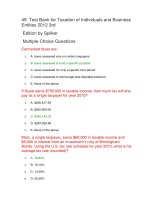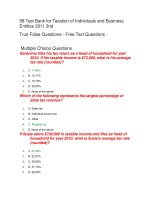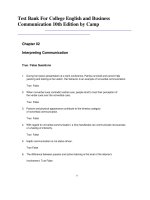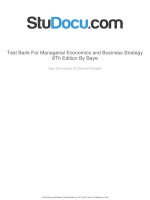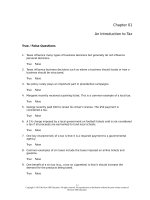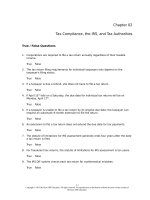Test bank taxation of individuals and business entities 2015 6e by brian c spilker chap011
Bạn đang xem bản rút gọn của tài liệu. Xem và tải ngay bản đầy đủ của tài liệu tại đây (816.4 KB, 88 trang )
Chapter 11
Investments
True / False Questions
1. Generally, interest income is taxed at preferential capital gains rates and dividend
income is taxed at ordinary rates.
True
False
2. Interest earned on U.S. savings bonds is interest received at sale or maturity but
must be taxed annually.
True
False
3. An investment's time horizon does not affect after-tax rates of return on investments
taxed annually.
True
False
4. When a taxable bond is issued at a premium, the taxpayer must calculate and apply
the yearly amortization amount to reduce a portion of the actual interest payments
that taxpayers include in gross income.
True
False
5. Qualified dividends are always taxed at a 15 percent preferential rate.
True
False
6. The capital gains (losses) netting process for taxpayers without 25 or 28 percent
capital gains requires them to (1) net short-term and long-term gains, (2) net shortterm and long-term losses, and (3) net the outcome to yield a final gain or loss to
place on the tax return.
True
False
7. Two advantages of investing in capital assets are (1) gains are generally deferred and
(2) gains are generally taxed at preferential rates.
True
False
8. Dave and Jane file a joint return. They sell a capital asset at a $150,000 loss. Even
though they have no capital gains, $6,000 of the loss can still be deducted in the
current year.
True
False
11-1
Copyright © 2015 McGraw-Hill Education. All rights reserved. No reproduction or distribution without the prior written consent of
McGraw-Hill Education.
9. Unrecaptured §1250 gain is taxed at the 28 percent preferential capital gains rate.
True
False
10. Losses associated with personal-use assets, sales to related parties, and wash sales
are not currently deductible.
True
False
11. Capital loss carryovers for individuals are carried forward indefinitely.
True
False
12. Investors must consider complicit taxes as well as explicit taxes in order to make
correct investment choices.
True
False
13. All life insurance proceeds given to the beneficiary at the time of death of the insured
are excluded from gross income.
True
False
14. §529 plans are limited to a yearly contribution of $2,000 for each beneficiary and can
only be used to pay for qualified educational costs incurred from kindergarten
through 12th grade.
True
False
15. With tax-exempt investment income, an investor's before-tax rate of return is greater
than her after-tax rate of return.
True
False
16. High-marginal rate taxpayers generally prefer municipal bonds and low-marginal rate
taxpayers generally prefer taxable corporate bonds.
True
False
17. Nondeductible investment expenses (other than investment interest expenses) are
carried forward indefinitely.
True
False
18. Taxpayers may make an election to include long-term capital gains and qualified
dividends in net investment income and deduct more investment interest expense
currently if they are willing to subject these sources of income to ordinary tax rates.
True
False
19. Investment expenses and investment interest expense are for AGI deductions.
True
False
11-2
Copyright © 2015 McGraw-Hill Education. All rights reserved. No reproduction or distribution without the prior written consent of
McGraw-Hill Education.
20. When electing to include long-term capital gains and qualified dividends in net
investment income, taxpayers must include all long-term capital gains and dividends
recognized for that year.
True
False
21. The investment interest expense deduction is limited to the amount of net
investment income for the year.
True
False
22. Generally, losses from rental activities are considered to be active losses.
True
False
23. Passive losses that exceed passive income are deferred until the taxpayer generates
passive income to offset these passive losses.
True
False
24. A loss from a passive activity is fully deductible as long as the taxpayer has sufficient
tax basis in the activity.
True
False
25. A passive activity is any activity that involves a trade or business or rental activity in
which the taxpayer does not materially participate.
True
False
26. To qualify under the passive activity rental real estate exception, the taxpayer must
(1) own at least 15 percent of the property and (2) participate in the process of
making management decisions.
True
False
Multiple Choice Questions
11-3
Copyright © 2015 McGraw-Hill Education. All rights reserved. No reproduction or distribution without the prior written consent of
McGraw-Hill Education.
27. If Jim invested $100,000 in an annual-dividend paying stock today with a 7 percent
return, what investment time period will give Jim the greatest after-tax return?
A. 1
year
B. 5
years
C. 10
years
D. 20
years
E. All yield the same after-tax
return
28. Which of the following types of interest income is not taxed as it is earned?
A. interest from savings
accounts
B. original issue discounts on corporate
bonds
C. accrued market discount on
bonds
D. interest from money market
accounts
E. All of
these
29. Nontax factor(s) investors should consider when choosing between investments
include:
A. before-tax rates of
return
B. after-tax rates of
return
C. liquidity
needs
D. before-tax rates of return and after-tax rates
of return
E. before-tax rates of return and liquidity
needs
11-4
Copyright © 2015 McGraw-Hill Education. All rights reserved. No reproduction or distribution without the prior written consent of
McGraw-Hill Education.
30. What rate should be used when calculating the after-tax future value of investments
with a constant rate of return that is taxed annually?
A. annual before-tax rate of
return
B. annual after-tax rate of
return
C. marginal tax
rate
D. preferential tax
rate
E. average tax
rate
31. If Tom invests $60,000 in a taxable corporate bond that provides a 5 percent beforetax return, how much will Tom's investment be worth in either 8 or 20 years from now
when the bond matures? Assume Tom's marginal tax rate is 35 percent.
A. $88,647;
$159,198
B. $92,782;
$178,414
C. $79,621;
$121,716
D. $77,495;
$113,750
E. None of
these
32. One primary difference between corporate and U.S. Treasury bonds is:
A. Treasury bonds always pay interest
periodically
B. Corporate bonds always pay interest
periodically
C. Interest from Treasury bonds is exempt from federal
taxation
D. Interest from corporate bonds is exempt from state
taxation
E. None of
these
11-5
Copyright © 2015 McGraw-Hill Education. All rights reserved. No reproduction or distribution without the prior written consent of
McGraw-Hill Education.
33. The amount of interest income a taxpayer recognizes when he redeems a U.S.
savings bond is:
A. the excess of the taxpayer's basis in the bonds over the bond
proceeds
B. the bond
proceeds
C. the excess of the bond proceeds over the taxpayer's basis in
the bonds
D. the taxpayer's basis in the
bonds
E. None of
these
34. Which of the following is not a tax advantage of a Series EE Saving Bond?
A. taxes are paid as the original issue discount on the bond is
amortized
B. interest earned is exempt from state
taxation
C. taxes are deferred until the bond is cashed in at
maturity
D. interest is exempt from federal taxation when used for qualifying
educational expenses
E. None of
these
35. When a bond is purchased in the secondary bond market at a discount, the amount
of discount treated as interest income when the bond is sold prior to maturity is the:
A. market
premium
B. market
discount
C. accrued market
premium
D. accrued market
discount
E. None of
these
11-6
Copyright © 2015 McGraw-Hill Education. All rights reserved. No reproduction or distribution without the prior written consent of
McGraw-Hill Education.
36. If Adam invested $25,000 in a stock paying annual dividends equal to 5% of his
investment, what would the value of his investment be 10 years from now assuming
that he reinvested his after-tax dividends each year? Assume Adam's marginal
ordinary tax rate is 15%.
A. $26,94
0
B. $40,72
2
C. $37,90
5
D. $101,13
9
E. None of
these
37. When selling stocks, which method of calculating basis provides the greatest
opportunity for minimizing gains or increasing losses?
A. LIFO
B. FIFO
C. Weighted
average
D. Specific
identification
E. None of
these
38. Long-term capital gains can be taxed at a maximum rate of:
A. 20
percent
B. 25
percent
C. 28
percent
D. Both 20 percent and 28
percent
E. All of
these.
11-7
Copyright © 2015 McGraw-Hill Education. All rights reserved. No reproduction or distribution without the prior written consent of
McGraw-Hill Education.
39. Cory recently sold his qualified small business stock (acquired in 2014) for $90,000
after holding it for ten years. His basis in the stock is $40,000. Assuming his marginal
tax rate is 35 percent, how much tax will he owe on the sale?
A. $3,75
0
B. $7,00
0
C. $7,50
0
D. $14,00
0
E. None of
these
40. In X8, Erin had the following capital gains (losses) from the sale of her investments:
$2,000 LTCG, $25,000 STCG, ($9,000) LTCL, and ($15,000) STCL. What is the amount
and nature of Erin's capital gains and losses?
A. $3,000 net short-term capital
gain
B. $3,000 net long-term capital
loss
C. $4,000 net short-term capital
gain
D. $4,000 net long-term capital
loss
E. None of
these
41. The netting process for capital gains (losses) with 0/15/20 percent, 25 percent, and
28 percent capital assets helps maximize the tax benefit of:
A. current year net loss in the 25 percent
rate group
B. net short-term capital
losses
C. long-term capital loss
carryovers
D. current year net loss in the 25 percent rate group and long-term capital loss
carryovers
E. net short-term capital losses and long-term capital loss
carryovers
11-8
Copyright © 2015 McGraw-Hill Education. All rights reserved. No reproduction or distribution without the prior written consent of
McGraw-Hill Education.
42. When the wash sale rules apply, the realized loss is:
A. recognized at time of
sale
B. not recognized at time of sale and does not affect basis of newly
acquired stock
C. recognized at time of sale and added to basis of the newly
acquired stock
D. not recognized at time of sale and added to basis of the newly
acquired stock
E. not recognized at time of sale and subtracted from the basis of the newly
acquired stock
43. The maximum amount of net capital losses individuals may deduct against their
ordinary income per year is:
A. $3,00
0
B. $5,00
0
C. Zero, losses are not
deductible
D. There is no maximum. All losses are allowed to be
deducted.
E. None of
these
44. In the current year, Norris, an individual, has $50,000 of ordinary income, a Net Short
Term Capital Loss (NSTCL) of $10,000 and a Net Long Term Capital Gain (NLTCG) of
$2,800. From his capital gains and losses, Norris reports:
A. an offset against ordinary income of
$10,000
B. an offset against ordinary income of $3,000 and a NSTCL carryforward
of $7,000
C. an offset against ordinary income of $2,800 and a NSTCL carryforward
of $7,200
D. an offset against ordinary income of $3,000 and a NSTCL carryforward
of $7,200
E. an offset against ordinary income of $3,000 and a NSTCL carryforward
of $4,200
11-9
Copyright © 2015 McGraw-Hill Education. All rights reserved. No reproduction or distribution without the prior written consent of
McGraw-Hill Education.
45. Ms. Fresh bought 1,000 shares of Ibis Corporation stock for $5,000 on January 15,
2012. On December 31, 2014 she sold all 1,000 shares of her Ibis stock for $4,500.
Based on a hot tip from her friend, she bought 1,000 shares of Ibis stock on January
23, 2015 for $3,000. What is Ms. Fresh's recognized loss on her 2014 sale and what is
her basis in her 1,000 shares purchased in 2015?
A. $-0- LTCL and $3,500
basis
B. $200 LTCL and $3,300
basis
C. $300 LTCL and $3,200
basis
D. $400 LTCL and $3,100
basis
E. $500 LTCL and $3,000
basis
46. Kevin bought 200 shares of Intel stock on January 1, 2014 for $50 per share with a
brokerage fee of $100. Then, Kevin sells all 200 shares for $75 per share on
December 12, 2014. The brokerage fee on the sale was $150. What is the amount of
the gain/loss Kevin must report on his 2014 tax return?
A. $4,50
0
B. $4,75
0
C. $5,00
0
D. $5,25
0
E. None of
these
47. If an individual taxpayer's marginal tax rate is 35 percent and he holds the following
assets for more than one year, which gain will be taxed at the highest rate at the
time of sale?
A. gain from investment
land
B. gain from personal-use
property
C. gain from a coin
collection
D. gain from the sale of qualified small business stock held
for 3 years
E. gain attributable to tax depreciation taken on real
property
11-10
Copyright © 2015 McGraw-Hill Education. All rights reserved. No reproduction or distribution without the prior written consent of
McGraw-Hill Education.
48. The longer the holding period on growth stocks, ____________ the after-tax rate of
return.
A. the
lesser
B. the
greater
C. there is no difference
between
49. Tom, from Nebraska, and Jill, from Missouri, recently got married. To earn a decent
return on all their wedding gifts, they decide to invest in some municipal bonds
issued by the state of Missouri. Assuming they both qualify as Missouri residents, the
bond interest Tom and Jill earn will be subject to the following taxes:
A. federal income taxes
only
B. federal and Missouri state income
taxes
C. Missouri state income taxes
only
D. Nebraska state income taxes
only
E. None of
these
50. Which of the following portfolio investments is incorrectly characterized (Investment Income Type - Timing of Taxation - Tax Rate)?
A. Growth stock - appreciation in capital assets - current capital gains
B. Municipal bonds - tax-exempt income - never
- zero
C. Savings account - taxable interest - current - ordinary
income
D. None of
these.
11-11
Copyright © 2015 McGraw-Hill Education. All rights reserved. No reproduction or distribution without the prior written consent of
McGraw-Hill Education.
51. When 529 plan distributions are not used for qualified higher education expenses,
these distributions are subject to an additional penalty of:
A. 5
%
B. 10
%
C. 15
%
D. 25
%
E. None of
these
52. Kevin has the option of investing in a municipal bond that provides a 4.5 percent
return or a taxable bond that provides a 7 percent return. Assuming Kevin's marginal
tax rate is 35 percent, what investment should he choose and why?
A. Taxable bond; provides a 4.55 percent return versus 4.5 percent return for the
municipal bond
B. Taxable bond; provides a 7 percent return versus 4.5 percent return for the
municipal bond
C. Taxable bond; provides a 4.55 percent return versus 2.9 percent return for the
municipal bond
D. Municipal bond; provides a 4.5 percent return versus 4.2 percent return for the
taxable bond
E. None of
these
53. What explicit tax rate would keep Jason indifferent between purchasing a municipal
bond with a 3.0 percent return and a taxable bond with a 4.5 percent before-tax
return? (Round your answer to the nearest percent)
A. 25
%
B. 30
%
C. 33
%
D. 36
%
E. None of
these
11-12
Copyright © 2015 McGraw-Hill Education. All rights reserved. No reproduction or distribution without the prior written consent of
McGraw-Hill Education.
54. Jim (life expectancy is 20 years) decides to purchase a life insurance policy for
$75,000 that promises a 9 percent annual return. Jim decides to cash in the policy
after five years while still living. Assuming Jim's marginal tax rate is 35 percent, what
are his after-tax proceeds? (Round all interim calculations to the nearest whole
number)
A. $14,13
9
B. $40,39
7
C. $101,25
8
D. $115,39
7
E. None of
these
55. Maximum yearly contributions per beneficiary to Coverdell Savings Accounts are
limited to:
A. $1,50
0
B. $2,00
0
C. $5,50
0
D. No limit on amount you contribute
yearly
E. None of
these
56. Emily invested $60,000 into a 529 account on January 1, 20X8 to fund her son's
future schooling. Five years later, Emily needs this money to purchase a new car for
the family. Her after-tax and penalty proceeds were $76,896. What is Emily's after-tax
and penalty rate of return?
A. 5.1
%
B. 6.1
%
C. 7.1
%
D. 8.1
%
E. None of
these
11-13
Copyright © 2015 McGraw-Hill Education. All rights reserved. No reproduction or distribution without the prior written consent of
McGraw-Hill Education.
57. Which of the following is not an example of the conversion tax planning strategy?
A. selling corporate bonds to purchase growth
stocks
B. selling U.S. Treasury bonds to purchase municipal
bonds
C. cashing in a certificate of deposit to purchase a stock paying qualified
dividends
D. withdrawing funds from a savings account to purchase a qualified small
business stock
E. None of
these
58. Life insurance policies have nontax factors that limit their desirability as an
investment vehicle. Some of these factors include:
A. waiting for the insured individual's
death
B. low expense to return
ratios
C. high commission
costs
D. waiting for the insured individual's death and low expense to
return ratios
E. waiting for the insured individual's death and high
commission costs
59. John holds a taxable bond and a municipal bond. Which fees are considered part of
John's investment expense?
A. attorney and accounting fees on
municipal bond
B. safe deposit box rental fees on taxable
bond
C. interest expense on taxable
bond
D. attorney and accounting fees on municipal bond and safe deposit box rental fees
on taxable bond
E. safe deposit box rental fees on taxable bond and interest expense on
taxable bond
11-14
Copyright © 2015 McGraw-Hill Education. All rights reserved. No reproduction or distribution without the prior written consent of
McGraw-Hill Education.
60. Bill would like some tax benefits for his investment expenses incurred this year. His
AGI is $190,000. Currently, his expenses consist of: (1) $1,000 investment advice
fees, (2) $1,500 unreimbursed employee business expenses (a miscellaneous
itemized deduction), and (3) $600 tax return preparation fees. How much more, if
any, must Bill spend for investment expenses this year before he receives any tax
benefit?
A. Zero, Bill is already receiving a
benefit
B. More than
$500
C. More than
$700
D. More than
$900
E. None of
these
61. When calculating net investment income, gross investment income includes:
A. interest
income
B. net short-term capital
gains
C. non-qualified
dividends
D. royalty
income
E. All of
these
62. Unused investment interest expense:
A. expires after the current
year
B. is carried back two
years
C. is carried forward twenty
years
D. is carried forward
indefinitely
E. None of
these
11-15
Copyright © 2015 McGraw-Hill Education. All rights reserved. No reproduction or distribution without the prior written consent of
McGraw-Hill Education.
63. Brandon and Jane Forte file a joint tax return and decide to itemize their deductions.
The Forte's income for the year consists of $120,000 in salary, $1,000 interest
income, $1,500 nonqualifying dividends, and $1,000 long-term capital gains. The
Forte's expenses for the year consist of $3,000 investment interest expense and
$900 tax preparation fees. Assuming that the Forte's marginal tax rate is 30%, what
is the amount of investment interest expense deduction for the year?
A. Zero; investment interest expense is below two
percent of AGI.
B. $1,00
0
C. $2,50
0
D. $3,00
0
E. None of
these
64. Investment expenses treated as miscellaneous itemized deductions do not include:
A. expenses incurred to generate tax-exempt
income
B. investment interest
expense
C. expenses for investment
advice
D. expenses incurred to generate tax-exempt income and investment
interest expense
E. investment interest expense and expenses for
investment advice
65. Investment interest expense does not include:
A. interest expense from loans to purchase municipal
bonds.
B. interest expense from loans to purchase corporate
bonds.
C. interest expense from loans to purchase
stocks.
D. interest expense from loans to purchase U.S. savings bonds and interest expense
from loans to purchase corporate bonds.
E. interest expense from loans to purchase corporate bonds and interest expense
from loans to purchase stocks.
11-16
Copyright © 2015 McGraw-Hill Education. All rights reserved. No reproduction or distribution without the prior written consent of
McGraw-Hill Education.
66. Assume that Joe has a marginal tax rate of 35 percent and decides to make the
election to include long-term capital gains and qualified dividends as investment
income. What rate must Joe use when calculating the tax on these two items?
A. 20
%
B. 25
%
C. 28
%
D. 35
%
E. None of
these
67. Doug and Sue Click file a joint tax return and decide to itemize their deductions. The
Click's income for the year consists of $90,000 in salary, $2,000 interest income,
$800 long-term capital loss. The Click's expenses for the year consist of $1,500
investment interest expense. Assuming that the Click's marginal tax rate is 35%,
what is the amount of their investment interest expense deduction for the year?
A. $1,20
0
B. $1,50
0
C. $2,00
0
D. $2,30
0
E. None of
these
68. Bob Brain files a single tax return and decides to itemize his deductions. Bob's
income for the year consists of $75,000 of salary, $3,000 long-term capital gain, and
$1,500 interest income. Bob's expenses for the year consists of $800 investment
advice fees, $700 unreimbursed employee business expenses (a miscellaneous
itemized deduction), and $250 tax return preparation fees. What is Bob's actual
deduction for miscellaneous itemized deductions?
A. Zero; Bob's investment expenses do not exceed two percent of
AGI floor.
B. $1,59
0
C. $1,50
0
D. $1,75
0
E. None of
these
11-17
Copyright © 2015 McGraw-Hill Education. All rights reserved. No reproduction or distribution without the prior written consent of
McGraw-Hill Education.
69. Alain Mire files a single tax return and has adjusted gross income of $304,000. His
net investment income is $53,000. What is the additional tax that Alain will pay on
his net investment income for the year?
A. Zer
o
B. $2,01
4
C. $3,95
2
D. $1,93
8
E. None of
these
70. What is the correct order of the loss limitation rules?
A. tax basis, at-risk amount, passive loss
limits
B. at-risk amount, tax basis, passive loss
limits
C. passive loss limits, at-risk amount, tax
basis
D. tax basis, passive loss limits, at-risk
amount
E. passive loss limits, tax basis, at-risk
amount
71. Sue invested $5,000 in the ABC Limited Partnership and received a 10 percent
interest in the partnership. The partnership had $20,000 of qualified nonrecourse
debt and $20,000 of debt she is not responsible to repay because she is a limited
partner. Sue is allocated a 10 percent share of both types of debt resulting in a tax
basis of $9,000 and an at risk amount of $7,000. During the year, ABC LP generated
a ($90,000) loss. How much of Sue's loss is disallowed due to her tax basis or at-risk
amount?
A. Zero; all of her loss is allowed to be
deducted
B. $2,000 disallowed because of her at-risk
amount
C. $2,000 disallowed because of her tax
basis
D. $4,000 disallowed because of her tax
basis
E. $4,000 disallowed because of her at-risk
amount
11-18
Copyright © 2015 McGraw-Hill Education. All rights reserved. No reproduction or distribution without the prior written consent of
McGraw-Hill Education.
72. Which taxpayer would not be considered a material participant of an activity?
A. taxpayer materially participated in the activity for any five of the
preceding ten years
B. taxpayer participated on a regular, continuous, and substantial
basis last year
C. taxpayer participated 95 hours last year and participation is not less than any
other participants for the year
D. taxpayer participated in the activity for 995 hours
last year
E. None of
these
73. Generally, which of the following does not correctly categorize the type of income?
A. rental real estate - passive
income/loss
B. salary - active
income/loss
C. dividends - portfolio
income/loss
D. capital losses - passive
income/loss
E. All of
these
74. Michelle is an active participant in the rental condominium property she owns. During
the year, the property generates a ($15,000) loss; however, Michelle has sufficient
tax basis and at-risk amounts to absorb the loss. If Michelle has $115,000 of salary,
$10,000 of long-term capital gains, $3,000 of dividends, and no additional sources of
income or deductions, how much loss can Michelle deduct?
A. Zero; losses from rental property are passive losses and can only be offset by
passive income.
B. $4,00
0
C. $11,00
0
D. $15,00
0
E. None of
these
11-19
Copyright © 2015 McGraw-Hill Education. All rights reserved. No reproduction or distribution without the prior written consent of
McGraw-Hill Education.
75. The rental real estate exception favors:
A. lower income taxpayers (AGI less than
$80,000)
B. middle income taxpayers (AGI greater than $80,000 and less than
$150,000)
C. upper income taxpayers (AGI greater than
$150,000)
D. lower income taxpayers (AGI less than $80,000) and middle income taxpayers (AGI
greater than $80,000 and less than $150,000)
E. middle income taxpayers (AGI greater than $80,000 and less than $150,000) and
upper income taxpayers (AGI greater than $150,000)
76. On the sale of a passive activity, any suspended losses cannot be used to offset
income from:
A. active business
income
B. capital
gains
C. interest
income
D. wages and
tips
E. None of
these
77. A taxpayer's at-risk amount in an activity is increased by:
A. a reduction in the amount of debt related to the activity that the taxpayer is
responsible for paying
B. cash contributions to the
activity
C. cash distributions from the
activity
D. a reduction in the amount of debt related to the activity that the taxpayer is
responsible for paying and cash contributions to the activity
E. a reduction in the amount of debt related to the activity that the taxpayer is
responsible for paying and cash distributions from the activity
Essay Questions
11-20
Copyright © 2015 McGraw-Hill Education. All rights reserved. No reproduction or distribution without the prior written consent of
McGraw-Hill Education.
78. Compare and contrast how interest income is reported for the following types of
bonds: (a) bond originally issued at a discount, (b) bond originally issued at a
premium, (c) bond purchased at a discount in a secondary market (d) bond
purchased at a premium in a secondary market.
79. What requirements must be satisfied before an investor may receive preferential tax
treatment on dividend income, and what preferential treatment will result?
11-21
Copyright © 2015 McGraw-Hill Education. All rights reserved. No reproduction or distribution without the prior written consent of
McGraw-Hill Education.
80. Susan Brown has decided that she would like to go back to school after her kids leave
home in five years. To save for her education, Susan would like to invest $25,000 in
an investment that provides a high return. If her marginal tax rate is 35 percent, what
is Susan's after-tax rate of return for the following investment options?
(1) Corporate bond issued at face value with 10 percent stated interest rate payable
annually
(2) Dividend-paying stock with an annual qualifying dividend equal to 10% of her
investment
(3) Growth stock with an annual growth rate of 8 percent and no dividends paid
(4) Municipal bond yielding a 6 percent annual return
(5) 529 plan with 7 percent annual return (all disbursements will be spent on
qualifying educational expenses).
(Round your interim calculations to the nearest whole number)
81. On January 1, 20X1, Fred purchased a corporate bond with a face value of $50,000
from the secondary market at a premium. The bond has a coupon rate of 8 percent
and matures in five years. The market rate of the bond is a 6 percent annual beforetax return compounded semiannually. If Fred was trying to minimize interest income,
what is the least amount of interest income Fred may report on his 20X1 tax return?
11-22
Copyright © 2015 McGraw-Hill Education. All rights reserved. No reproduction or distribution without the prior written consent of
McGraw-Hill Education.
82. What impact does an investment time horizon have on the after-tax returns from a
portfolio producing interest and dividend income annually?
83. On December 1, 20X7, George Jimenez needed a little extra cash for the upcoming
holiday season, and sold 250 shares of Microsoft stock for $50 per share less a
broker's fee of $200 for the entire sale transaction. Prior to the sale, George held the
following blocks of Microsoft stock (associated broker's fee paid at the time of
purchase):
If his goal is to minimize his current capital gain, how much capital gain will George
report from the sale?
84. What are the rules limiting the amount of capital losses a taxpayer may deduct in a
given year? Name at least three.
11-23
Copyright © 2015 McGraw-Hill Education. All rights reserved. No reproduction or distribution without the prior written consent of
McGraw-Hill Education.
85. Henry, a single taxpayer with a marginal tax rate of 35 percent, sold the following
assets during the year:
*The original purchase price of the rental home was $75,000. The current tax basis
reflects $25,000 of tax depreciation taken.
What tax rate(s) will apply to Henry's capital gains or losses?
11-24
Copyright © 2015 McGraw-Hill Education. All rights reserved. No reproduction or distribution without the prior written consent of
McGraw-Hill Education.
86. Scott Bean is a computer programmer and incurred the following transactions last
year.
What is the Net Short-Term Capital Gain/Loss reported on the 2014 Schedule D? What
is the Net Long-Term Capital Gain/Loss reported on the 2014 Schedule D? What
amount of capital gain is subject to the preferential capital gains rate?
87. Mr. and Mrs. Smith purchased 100 shares of stock for $45 per share on June 30, 20X6.
On March 30, 20X8, the Smith family decides to sell these shares for $30 generating
a loss of $15 per share. On April 15, 20X8, the Smith family realized they made a
mistake and repurchased 100 shares for $35 per share. When will the Smith family
receive a tax benefit for the loss on the March 30, 20X8 sale?
11-25
Copyright © 2015 McGraw-Hill Education. All rights reserved. No reproduction or distribution without the prior written consent of
McGraw-Hill Education.
